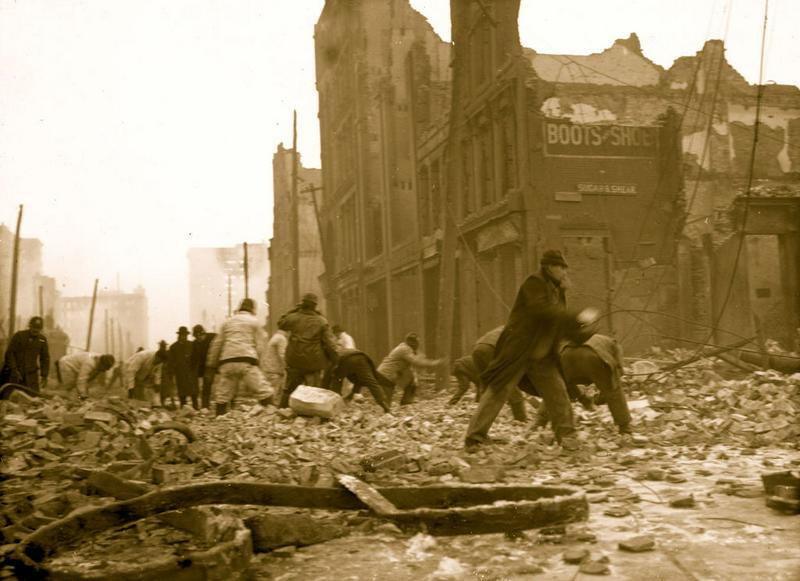1904 Baltimore Fire: 80 Blocks Burned And Lessons Learned
By | February 5, 2020

Chicago doesn't have a monopoly on destructive, city-wide fires. On February 7, 1904, one such fire swept through 80 blocks of Baltimore, Maryland, leveling more than 1,500 buildings and damaging an additional 1,000 structures. Only the Great Chicago Fire of 1871 was more destructive, but out of the ashes of the 1904 Baltimore Fire came some much-needed and potentially life-saving changes in how we fight fires. Let's look at the 1904 Baltimore Fire, its causes, the damage, and the improvements that came from this event.

Turn-Of-The-Century Cities Were Powder Kegs
American cities at the turn of the century were very different from modern cities. Buildings were constructed of wood and built in close proximity to each other, fire breaks weren't built into city planning, and building codes were either nonexistent or not enforced. Many streets and alleys were often crowded with cars, wagons, and discarded items, while others were just too narrow for fire trucks to squeeze through under even the best conditions. They were basically fire hazards that thousands of people lived in.

1904 Firefighting Was Similarly Troubled
Since Benjamin Franklin founded the country's first fire department in Boston in 1736, most major cities had dedicated firefighters. (Smaller towns and villages relied on volunteers from the community to serve as firefighters when needed, a practice that is still common today.) In 1904, Baltimore had a professional and well-trained fire department, but their equipment was woefully inadequate. Pumpers and tankers were pulled by teams of horses, and equipment varied across different departments.

A Discarded Cigarette And A Strong Wind
The first report of a fire came in at 10:48 A.M. on February 7, claiming that someone had tossed a smoldering cigarette into the basement of the Hurst Building on West German Street. By the time firefighters arrived on the scene, the building was engulfed in flames, and the winds from the harbor were fanning the fire in the direction of neighboring buildings in the downtown district. Thankfully, it was Sunday morning, so few people were working in the area.

Calling For Mutual Aid
The fire quickly grew out of control, spreading rapidly from one downtown building to another. The Baltimore fire department soon realized they were out of their depth, so they sent out messages via telegraph to surrounding communities, asking them to send equipment and manpower for mutual aid. Several departments responded to the call, but getting to Baltimore wasn't as easy as turning on a siren and watching traffic part like the Red Sea. Remember, the tankers were pulled by horses. Firefighters in nearby Washington, D.C. loaded their tankers onto rail cars and took the Baltimore and Ohio Railroad to Baltimore, arriving around 1:30 P.M. Other departments arrived throughout the afternoon and evening; a total of 1,231 firefighters helped put out the flames.

An Equipment Issue
When the fire departments from surrounding areas arrived in Baltimore to fight the fire, they were stymied by a major equipment issue: The hoses they brought were useless. Since there was no industry standard for firefighting equipment at the time, their hose couplings didn't fit the fire hydrants in Baltimore. They could only watch helplessly as the fire raged on.

The Problem Was Not Unique To Baltimore
Although the local fire department was criticized for the equipment issues, the problem was not unique to Baltimore. In the early 1900s, each city had its own hydrant system. Equipment manufacturers at that time designed and patented their own products without concern for whether their products were compatible with other products or systems. At the time of the 1904 Baltimore Fire, there were more than 600 different sizes and configurations of fire hose couplings in the United States. It would have been a miracle if the responding fire departments did have compatible equipment.

A Destructive Scene
It took about 30 hours for the fire to be extinguished, which was plenty of time to devastate the city. An 80-block area of downtown Baltimore was in ashes, leaving more than 1,500 buildings completely destroyed and an additionally 1,000 heavily damaged. The estimated cost of the fire was $100 million. There was some good news: The beautiful domed City Hall of Baltimore was saved, and since the fire was confined to the downtown district, no homes were destroyed and no one was killed in the blaze. Many workers were displaced because their workplaces were destroyed, but at least no one was forced into a fiery retirement.

The Call For Standardization In The Fire Service
The 1904 Baltimore Fire was a wakeup call to the country's fire services. Although there had been discussions in the past about the need to standardize equipment, particularly hose couplings, most equipment manufacturers were unwilling to deviate from their own patented designs, and municipalities were unwilling to spend the money to change all the hydrants in their cities. After the Baltimore fire, however, the people demanded upgraded building codes and the standardization of firefighting equipment in the United States, starting with hose couplings. Today, out-of-town fire departments have no problem hooking up their hoses to any fire hydrant in the country. Ditching the horses was a pretty big help, too.

